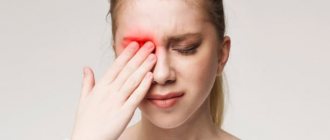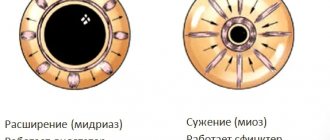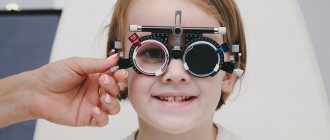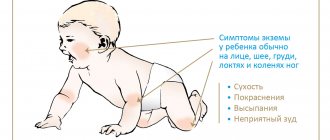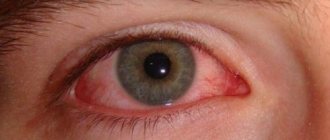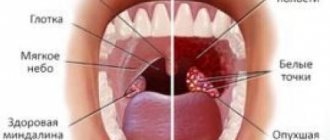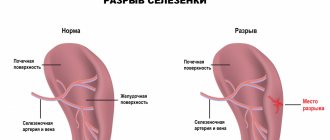In this article we will tell you:
- What does tear fluid consist of?
- Excessive tearing
- Hypersecretory epiphora
- Retention epiphora
- Watery eyes and contact lenses
- Watery eyes: treatment
Joy and sadness, pain and relief - how many emotions in our everyday life are associated with tears! We start life with them, we meet and see off our dear people with them. Without even thinking about it, we use our tears every day to keep our eyes healthy.
However, sometimes lacrimation can become too strong - and this pathological condition can be explained. A watery eye in an adult: causes, possible diseases and treatment methods - in our article.
Tear fluid
- a special secret produced by paired lacrimal glands located in the lacrimal fossa: a special depression in the frontal bone, on the outer side of the eye sockets. The fluid flows through the excretory canaliculi from the glands into the conjunctival sac and accumulates under the lower eyelid. The function of the upper eyelid is its distribution over the surface of the eyeball.
The lacrimal fluid that has fulfilled its purpose is discharged through special drainage tracts - lacrimal stream, lake and canaliculi - into the lower nasal passage, where it continues to provide benefits by moisturizing the mucous surface. Its remains evaporate there.
What does tear fluid consist of?
The composition of the secretion of the lacrimal glands is similar to plasma: up to 98% water, the rest is organic compounds, fats, proteins, carbohydrates, enzymes and inorganic substances, including sodium chloride. Just like a drop of blood, a tear can tell a lot about what ails a person. Its composition constantly changes depending on the state of the body, so analysis of tear fluid is informative in the diagnosis of certain diseases.
Features of the composition help tears:
- moisturize the external tissues of the organ of vision and nasopharynx.
- saturate them with nutrients.
- heal corneal injuries.
- protect your eyes from germs.
The enzyme lysozyme, a natural antibiotic with bactericidal and antiviral properties, is responsible for the latter function. It destroys the membranes of pathogenic cells and creates an antibacterial barrier on the mucous membranes of the eye.
The protective function of the tear fluid also lies in mechanical cleansing: when foreign particles enter the eye, more secretion is released, and the tear stream washes away the debris.
In addition, some hormones are removed from the body with tear fluid. In stressful situations, when emotions run high, tears bring relief: this is due to a decrease in the concentration of adrenaline and, as a result, emotional release.
Watery eyes: causes and treatment with modern methods
One simple way to symptomatically treat tearing is eye drops. They have different compositions, so they can be used for dry eye syndrome, conjunctivitis and other diseases. The choice of solution is made only by a doctor after a thorough diagnosis and clarification of the causes of the pathological condition.
If we are talking about excessive production of tears caused by dryness or fatigue of the visual organs, computer syndrome, hypofunction of the lacrimal glands, you can use Delfanto® as an alternative to drops.
This innovative product appeared in Russia in 2021. It has a completely natural composition. The basis of Delfanto® capsules is a standardized MaquiBright® extract, which contains 35% antioxidants. The active components of the extract help eliminate the effects of oxidative stress and restore cells of the lacrimal glands. They also improve the quality of tear fluid and normalize its production.
The drug Delfanto® has undergone clinical testing. It can be used simultaneously with eye drops. But already a few weeks after the start of therapy, you can abandon ophthalmic solutions as unnecessary.
Excessive tearing
Under normal conditions, the lacrimal glands secrete 0.5 to 1 ml of fluid per day. With insufficient production, a person develops symptoms of dry eye: pain, sensation of a foreign object, redness, and in more complex cases, ulcerations on the cornea. In the opposite situation - if too much tear fluid is produced - experts talk about excessive lacrimation or epiphora. This condition can be either physiological or pathological, and requires consultation with an ophthalmologist: he will accurately determine the reason why your eyes are watery.
Physiological lacrimation from the eyes is caused by the body’s attempt to protect the organ of vision in unfavorable conditions for it. So, a large amount of secretion begins to be produced when exposed to:
- bright sunlight, harsh artificial lighting;
- cigarette smoke, exhaust gases;
- frosty air, strong wind;
- foreign body;
- dry indoor air;
- caustic seasonings, odors.
This kind of eye lacrimation is called reflex. A person’s condition normalizes itself as soon as the irritating factors disappear. In this case, no treatment is required.
If excessive lacrimation is associated with diseases of the body, it is classified as a pathological condition. The reasons may be:
- allergies. One of the symptoms of an allergic eye reaction is excessive tearing. It can begin upon contact with plant pollen (hay fever), cosmetics, household chemicals, animal hair, dust, food allergens, medications - all those substances that can cause such a response in the body.
- Vitamin deficiencies. One of the symptoms of a lack of B vitamins and potassium can be excessive tearing.
- Diseases of viral and bacterial nature, inflammatory processes. Infections affecting the eyes or nasopharynx often lead to a pathological increase in the secretion of the lacrimal glands.
- Severe eye fatigue. Constant tension in the organ of vision can lead to the production of tear fluid in a volume exceeding normal levels.
- Endocrine, neuropsychological disorders. For example, damage to the first branch of the facial nerve or thyrotoxicosis.
- Problems with the outflow of tear secretion due to injuries, chronic diseases, age-related characteristics (senile blepharoptosis).
Depending on the location of the pathological process, experts distinguish hypersecretory epiphora, associated with excessive secretion production, and retention epiphora, which arises due to a violation of the discharge of tear fluid.
Hypersecretory epiphora
With this type of pathological lacrimation, the tear glands produce too much fluid.
The causes of hypersecretory epiphora can be:
- glaucoma;
- viral, bacterial, mycotic (fungal) tissue damage;
- inflammation of the cornea and conjunctiva.
Retention epiphora
Watery eyes occur because fluid cannot leave the eye through the tear ducts due to narrowing or blockage.
Causes:
- disruption of the lacrimal canal: its narrowing or fusion;
- dacryocystitis - inflammation of the lacrimal sac;
- pathological conditions of the nasal mucosa: swelling, severe runny nose, neoplasms, sinusitis;
- incorrect position – eversion – eyelid.
Excessive tearing can affect both eyes or just one eye. The disease often spreads to both eyes due to exposure to environmental factors, allergies, and infectious diseases. One eye suffers from neurological pathologies, as well as from physiological or functional disorders: abnormal structure of the eye, eversion of the eyelids, etc.
Table of contents:
Causes of tearing Classification Symptoms and diagnosis Treatment of tearing eyes Prevention
Tearing is a natural process. The fluid secreted by the tear glands moisturizes the surface of the eye and protects the mucous membrane from dust and other particles. Excessive lacrimation occurs during inflammatory processes. It signals the development of ophthalmopathology. Treatment of tearing eyes should be carried out under the supervision of a doctor, since if treated incorrectly, the infection can lead to suppuration and deterioration of vision.
Watery eyes and contact lenses
Sometimes, when using lenses that have expired, incorrect selection, or poor quality care for them, tearing may occur. It is explained:
- microtraumas that appear on the conjunctiva due to deformed lenses;
- infection;
- an allergic reaction to the components of soft contact lens care products, or to the components of the blister solution (even for daily contact lenses);
- constant eye strain due to incorrectly selected diopters;
- irritation from low-quality lenses or lens care compositions.
Ophthalmologists will help you avoid these unpleasant situations: obtain a Bausch&Lomb® certificate for vision diagnostics, which is carried out under optical conditions, and the selection of free contact lenses.
The doctor will tell you how to wear contact lenses, how to properly clean them, when you need to replace the lenses with new ones, and, of course, what to do if your eyes water when using them.
Eye diseases
This is the second, and in terms of frequency of cases, perhaps the first cause of redness, profuse lacrimation and cutting pain in the eyes. If you wake up in the morning and feel a tingling sensation in your eye, and in the mirror you see that it is seriously red and swollen, then it’s time to go to the ophthalmologist, because this may be one of the first signs of conjunctivitis - inflammation of the retina, which is caused by infection. True, there are a number of other diseases that manifest themselves with similar symptoms (tingling and redness of the eyes).
In the case of an infectious eye infection (for example, the eyelids sting due to blepharitis and barley, which are also infectious diseases), the necessary treatment is prescribed by a doctor. However, do not forget a few basic truths. For a viral infection, for example, herpes, influenza, it is necessary to take antiviral drugs. The most effective among them is interferon, which is produced in various pharmacological forms. In general, interferon is a substance produced by the human body, which is synthesized on the 7th day from the onset of the disease, precisely to repel various types of viruses by the immune system. However, for example, this same herpes is very latent to the interferon produced and is therefore dangerous. In other words, the body initially does not recognize herpes as a virus, which requires urgent production of interferon to combat. That is why you need to start treatment immediately.
In the case of a bacterial infection, which is most often caused by staphylococci and streptococci, it is worth acting comprehensively, including antibiotics in therapy. The human body is not capable of producing substances that can kill a particular infection completely, so the use of antibacterial agents is mandatory. But our body can keep invading infections under control for quite a long time due to its own immunity, for which it is necessary to strengthen the immune system. In this regard, vitamin C, retinol, and B vitamins are becoming universal remedies.
Why do my eyes water on the street?
So, we have found out how the lacrimal organs are structured, as well as the role of the fluid in protecting the eyes. And it was noted above that its excessive release is a sign of the influence of external or internal factors. It is not uncommon to experience watery eyes on the street. Why might this happen?
The main reason is weather conditions. This phenomenon is often observed in the cold season - frost in winter, cold winds in different seasons, snowstorms. Tear fluid evaporates faster, and the channels begin to produce it more intensely to protect the eyes from drying out. Doctors recommend protecting your eyesight during the cold season and not eating a lot of salty foods, as this causes water retention in the body.
It also explains why eyes become very watery outside and in the warm season. This happens when we accidentally look at the bright sun or spend a long time in unusual conditions, for example, this is possible on vacation in a hot tropical country. Under such conditions, the mucous membrane is also susceptible to drying out more quickly, so the tear ducts begin to intensively produce fluid. In such situations, ophthalmologists advise using sunglasses, as well as special means (drops, ointments).
Summing up
You need to remember that there are only three reasons for eye irritation and watery eyes: a temporary irritant, an allergic reaction and an infection. In case of short-term irritation, everything is simple: you need to rinse your eyes and drip soothing drops. With allergies, in general, it’s also not very difficult, because an adult, as a rule, already knows whether he is prone to allergies or not. But in the case of eye infections, everything is quite serious. Therefore, if the symptoms of eye stinging, irritation and watery eyes do not go away within 24 hours, a trip to the ophthalmologist is mandatory.
Fatigue
Why is my right eye watering? The most common cause is ordinary overstrain of the visual organ. Lack of sleep can cause problems. A common factor is prolonged exposure to a computer monitor, when the membrane of the eye is not sufficiently moistened with tear fluid.
If your right eye is watering due to fatigue, it is important to give your visual organs a good rest. Go for a walk, take a relaxing bath, exercise, wash your face and sleep. People who are forced to sit at a computer for hours every day should take short breaks between work and avoid eating in front of the monitor. By neglecting these recommendations, you can develop chronic fatigue of the visual organs, which will cause regular lacrimation and visual impairment.
Diagnostics
To identify the cause of the condition, you need to contact an ophthalmologist who will conduct several diagnostic tests to determine it:
- Questioning the patient. He can talk about experienced mechanical injuries and burns. May also complain of the onset of symptoms after improper use of lenses.
- General inspection. The doctor examines not only the organ of vision, but also the general condition of the patient. Often, increased tearing in only one eye can be caused by an infection or virus. Then the patient will have a symptom of malaise, elevated body temperature. Also, increased lacrimation is often accompanied by redness and inflammation of the eyes.
- Examination of the mucous membrane using a slit lamp. This method is suitable for detecting a foreign body.
- Checking your vision. For this purpose, diagnostic tables are used, which depict letters or pictures. The more lines the patient sees, the better his visual acuity. Often, without treatment, with the development of infectious and inflammatory eye diseases, visual acuity in the affected organ decreases.
- Fundus examination. The technique is carried out to exclude intraocular diseases. First, the patient is instilled with a solution onto the mucous membrane of the eyes, which prevents the accommodation of the pupil. It expands completely, so the doctor can identify the condition of all intraocular elements.
- Bacterial culture. The technique is used to identify bacteria that cause increased tearing. The laboratory doctor will determine the pathogen, as well as the antibiotic to which he is sensitive.
- PCR is a method that determines the exact type of virus that causes the disease.
- Diagnosis of the lacrimal canal and sac. The technique is used if the doctor suspects a blockage or an infectious-inflammatory process in this area.
After a complete diagnosis of the patient’s condition, the doctor can make a reliable diagnosis and prescribe treatment.
Antiallergic drops
"Allergodil" Liquid for eliminating allergy symptoms, relieves excessive lacrimation, hyperemia and swelling of the mucous membrane, itching of the eyelids, discomfort, sensation of a foreign body in the eyes. The main active component of the drops is azelastine hydrochloride (50 mcg per 1 ml). The product is suitable for the effective treatment of seasonal allergic manifestations, especially in the case of a reaction to flowering plants, when tear fluid is released in large quantities. Allergodil has a prolonged period of action and is well tolerated even in childhood. These drops can be used for a long time without adverse reactions or addiction.
"Opatanol" Antiallergic drug with double action. Blocks receptors sensitive to histamine, which is a provocateur of allergic and inflammatory reactions in the body. The drops stop the development of inflammation, reducing swelling, itching, and lacrimation. "Opatanol" has an effect on mast cells (granulocytes). It prevents the release of active substances that provoke an inflammatory reaction. This property distinguishes it from antihistamines, the side effect of which was the lysis (destruction) of granulocytes. The drug shows effectiveness in treating many types of allergic reactions. Suitable for a long period of treatment (but not more than 4 months). Indications for use: hay fever, seasonal and viral conjunctivitis, keratitis. Before instillation, the bottle of liquid must be warmed in your hand for several minutes and then shaken well.
"Ketotifen" This drug is available in the form of drops, tablets and syrups (for the treatment of children over 12 years old). In addition to its antiallergic effect, it also eliminates the symptoms of inflammation and stabilizes the condition of mast cell membranes, preventing the spread of histamines, which cause an irritant reaction. The drug is also a prophylactic agent, and for chronic forms of hay fever it is recommended to use it 3-4 weeks before flowering. This helps to significantly reduce the manifestations of allergic reactions, including lacrimation. If instillations are carried out at the same time each time, the effect of use will be much higher. Despite its strong therapeutic effect, Ketotifen is characterized by a large number of adverse reactions. If, when using the drops, you feel a headache, runny nose, dryness, or rashes in the eye area, then you should stop using them immediately and contact a specialist to prescribe another remedy.
Antihistamine drops also have general contraindications for use: glaucoma, infectious eye diseases, patient age, hypersensitivity to individual components. During the instillation period, it is unacceptable to wear contact lenses - you need to replace them with glasses.
Children's antiallergic drops If a child develops allergy symptoms (most often it is seasonal hay fever), the specialist will prescribe drops that will be safe for the child's body. These are the drugs “Lecrolin”, “Opatanol”, “Albucid”, “Azelastine”. Each age has its own remedy, so only a doctor can prescribe it after examination.
Antibacterial agents
One of the effective antibiotics for eliminating lacrimation in inflammatory diseases of the organs of vision is Okomistin - eye drops whose action is based on miramistin. They are applied topically and immediately begin to actively influence gram-positive and gram-negative microorganisms, some types of viruses, fungi, chlamydia and other types of bacteria. "Okomistin" is prescribed for rapid treatment of eye pathologies such as: keratouveitis, acute conjunctivitis, keratitis of any etiology, blepharoconjunctivitis. When used with other antibiotics, the drug has an enhancing antifungal and antibacterial effect.
"Albucid" The most common bacteriostatic and antiseptic drug for topical use. The drug contains sulfonamide, which suppresses many pathogenic microorganisms - gonococci, chlamydia, toxoplasma, streptococci and others, preventing their reproduction. Its advantages are low price and sufficient effectiveness in the initial stages of the disease. Can be used even during pregnancy and for newborns.
“Floxal” The active ingredient of the drops is ofloxacin, a component that has an active effect on various pathogenic microorganisms. It is effective even in treating diseases caused by bacteria that are resistant to most antibiotics.
What do you need to know when using medicinal drops?
The causes of increased lacrimation can be very different; we have listed them above. You should not engage in self-diagnosis, but you need to visit a specialist to determine the etiology of this phenomenon. If during therapy unpleasant sensations occur in the eye area, especially when pus and inflammation appear, instillations should be stopped immediately and consult a specialist for advice. He will identify the cause and prescribe another drug. Remember - only competent and timely treatment can bring the expected effect.
MagazinLinz.ru team
Nervous tension
When the right eye is watery, nervous strain may play a role. Neuropsychological disruptions in the body often lead to abundant secretions of local glands. This is often observed during periods of irritability and emotional outbursts. To eliminate trouble, you should avoid various kinds of stressful situations.
Lacrimal organs
The lacrimal glands are located in the upper outer part of the orbit, formed by the frontal bone. It is they who produce fluid, which then enters under the lower eyelid and spreads throughout the eye, and the excess flows into the nasolacrimal duct and evaporates there. It is secreted even while we sleep, and its volume is approximately 1 mm per day. With excessive crying (what is called “crying your eyes out”), up to 10 ml of tears can be released - approximately 2 teaspoons.
Why do an adult’s eyes water: the main functions of the liquid
Tears perform a vital protective function for our eyes. They form a thin protective film on the surface, protecting against the effects of environmental factors, and also moisturize the mucous membrane and nasopharynx.
Also, tear fluid has a powerful antibacterial effect. It contains the enzyme lysozyme, which is capable of eliminating microorganisms. Thanks to it, the eyes are under reliable protection, regardless of constant contact with the external environment.
Tears help us even when we cry from grief. Together with them, the body gets rid of unnecessary hormones produced as a result of a stressful situation. This is why excessive fluid secretion is a standard reaction to strong emotional overstimulation: a high amount of hormones has a negative effect on the psyche, and wise nature relieves us of them by removing them along with the fluid. It’s not for nothing that we feel relieved after we cry. The same scheme also works with a strong release of adrenaline (“tears of joy”).
The fluid also provides nutrition to the cornea, which is devoid of its own blood vessels.
Using inappropriate cosmetics
Often, increased lacrimation results from irritation of the mucous membranes of the visual organ by chemical components of cosmetics. It is not difficult to determine whether this is really the cause of the problem. It is enough to stop using cosmetics for a while. A change in the overall picture for the better will indicate the need to change one or another product.
